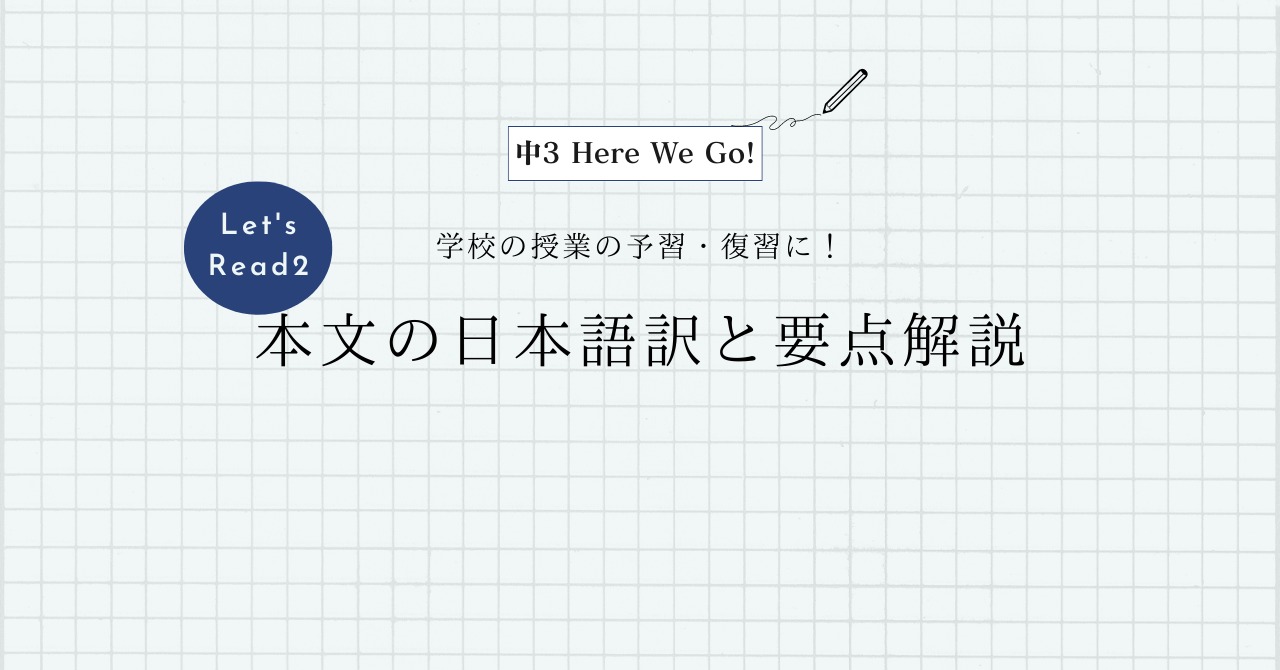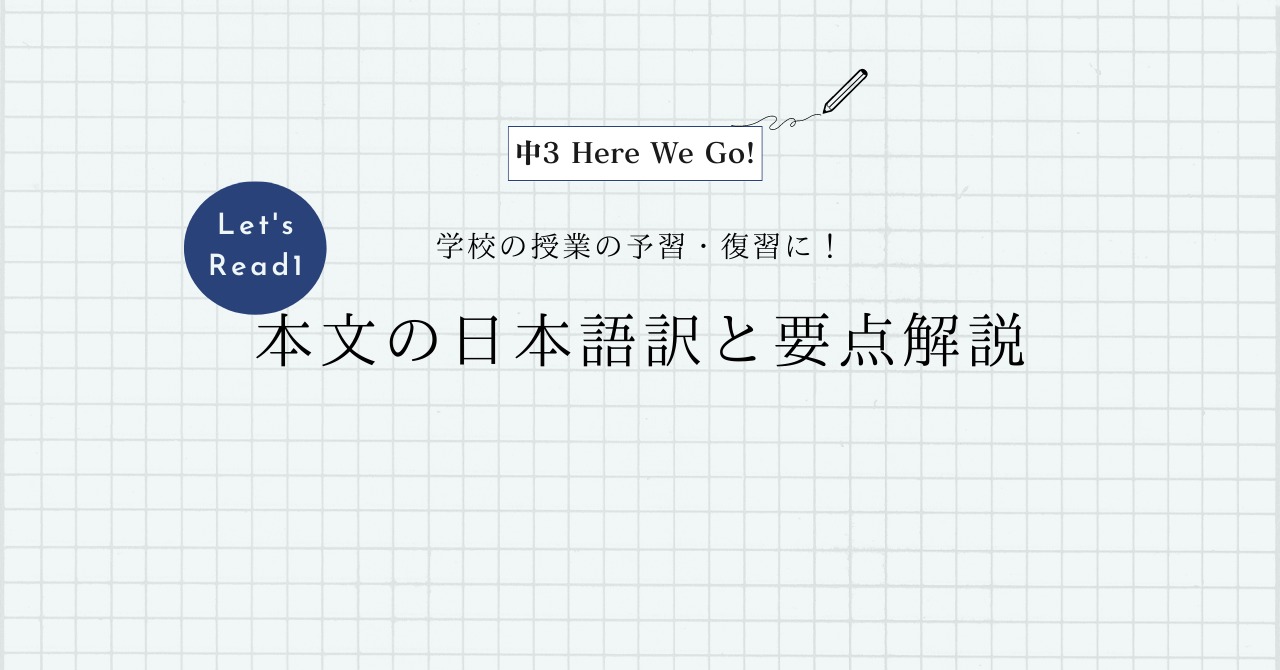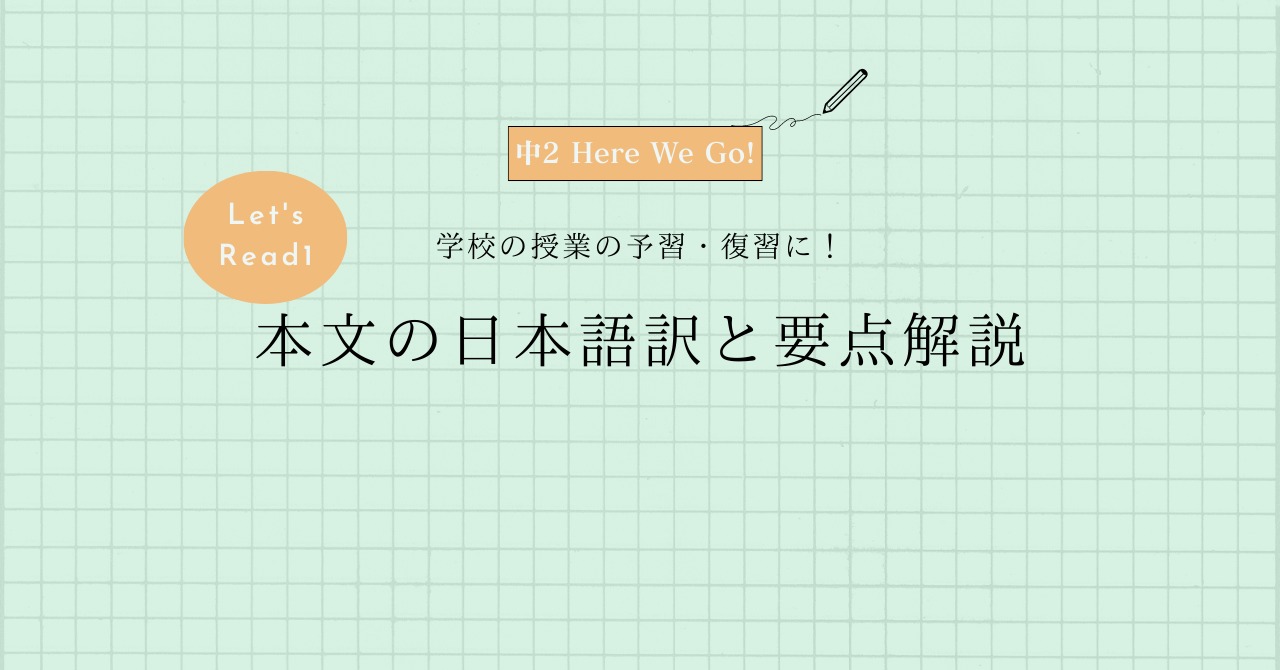光村図書 中学3年生 Here We Go! Let’s Read2の本文の日本語訳と重要箇所の解説です。
現代において,私たちの生活の欠かせない存在になっているロボットについてのお話です。
日常生活だけでなく,介護や災害現場,宇宙で活躍するロボットもいます。さらにはカフェで活躍するロボットもあり,そのようなロボットのおかげで,障害を持つ方も今は普通の人と同じように仕事に就くことができています。
では具体的にロボットがどういった形で貢献しているのかを一緒に見ていきましょう!
>中3Here We Go! Let’s Read1 本文和訳
>中3Here We Go! Let’s Read3 本文和訳①
>中3Here We Go! Let’s Read3 本文和訳➁
- Let’s Read2 本文と日本語訳
- 重要語句
- Let’s Read2 重要事項の解説
- Robots Make Dreams Come True
- When you hear the word “robot,” what kind of robot do you imagine?
- Some people think of anime characters, some people think of the human-like robots that talk to people, and some people think of robots that work in factories.
- In the modern world, people are supported by robots that have a variety of shapes, sizes, and roles.
- This is a robot that helps you learn English conversation.
- By talking to it again and again, you can improve your English-speaking skills.
- It can help people carry heavy things.
- It can search areas that are too dangerous for humans.
- Robonaut 2 is a Human-like robot that helps astronauts on the ISS (International Space Station).
- This has been a dream for many people with severe physical disabilities.
- Now we have a robot that can help.
- It’s a staff robot at a cafe in Japan that opened in autumn of 2018.
- He is a 25-year-old man who has serious disease.
- Now OriHime lets him work at a cafe.
- He watches a live video that is sent from the robot’s eyes and he talks through a microphone.
- This way, he can serve customers who come to the cafe.
- On the first day of his job at the cafe, it was difficult for Mr. Nagahiro to start conversations with customers.
- He didn’t have much experience at places like cafes.
- He asked her to give him some advice.
- The other OriHime user said, “You should de friendlier. When I serve customers, I always try to make friends with them.”
- Thanks to this experience, he now wants to try more challenges in the future.
- The person who invented OriHime is Yoshifuji Kentaro.
- When he talked to them, they usually said, “I wish I could connect myself with society.”
- It helps him work at a cafe.
- At first, it was difficult for him to start conversations with customers.
- Let’s Read2 まとめ
Let’s Read2 本文と日本語訳
Robots Make Dreams Come True「ロボットが夢を実現させる」
When you hear the word “robot,” what kind of robot do you imagine?
「『ロボット』という単語を聞いて,あなたはどんな種類のロボットを想像しますか?」
Some people think of anime characters, some people think of the human-like robots that talk to people, and some people think of robots that work in factories.
「アニメのキャラクターを考える人もいれば,人と話す人間のようなロボットを考える人もいるでしょうし,またある人は工場で働くロボットを考えるでしょう。」
In the modern world, people are supported by robots that have a variety of shapes, sizes, and roles.
「現代では,人々は様々な形,大きさ,役割を持つロボットによって支えられています。」
Scientists are continuing to invent more and more useful robots.
「科学者はより役に立つロボットを発明し続けています。」
Now, let’s look at some examples.
「では,いくつか例を見てみましょう。」
How do robots make people’s dreams come true?
「どのようにしてロボットは人々の夢を実現させているのでしょうか?」
Talking Robot「話すロボット」
This is a robot that helps you learn English conversation.
「これは英会話を学ぶのを手伝うロボットです。」
By talking to it again and again, you can improve your English-speaking skills.
「ロボットと何度も話すことで,英会話のスキルを向上させることができます。」
Robot Suit「ロボットスーツ」
This is HAL, a robot suit.
「これはHALというロボットスーツです。」
It can help people carry heavy things.
「それは人が重いものを運ぶのを助けることができます。」
It’s useful in places such as hospitals and factories.
「病院や工場のような場所で役立ちます。」
Rescue Robot「救助ロボット」
This is a rescue robot.
「これは救助ロボットです。」
It can search areas that are too dangerous for humans.
「それは人間にとってあまりに危険な場所を調査できます。」
After the Great East Japan Earthquake in 2011, it was used at the Fukushima Daiichi Nuclear Power Station.
「2011年の東日本大震災の後,福島第一原子力発電所で使われました。」
Space Robot「宇宙ロボット」
NASA is developing robots, too.
「NASAもロボットを開発しています。」
These robots can explore space and work with astronauts.
「これらのロボットは宇宙を探索し,宇宙飛行士と働くことができます。」
Robonaut 2 is a Human-like robot that helps astronauts on the ISS (International Space Station).
「ロボノート2はISS(国際宇宙ステーション)で宇宙飛行士を助ける人間のようなロボットです。」
It was sent there in 2011.
「2011年にそこに送られました。」
Another example is Insight.
「別の例はインサイトです。」
It is a machine with a robot arm.
「それはロボットの腕をもつ機械です。」
It reached Mars in 2018.
「2018年に火星に到着しました。」
Avatar Robot OriHime-D「アバターロボット オリヒメ-D」
“I want to work like other people.”
「『他の人と同じように働きたい。』」
This has been a dream for many people with severe physical disabilities.
「これは重い身体的な障害をもつ多くの人の夢であり続けています。」
Now we have a robot that can help.
「今は,助けてくれるロボットがいます。」
Its name is OriHime.
「その名前はオリヒメです。」
It’s a staff robot at a cafe in Japan that opened in autumn of 2018.
「2018年の秋にオープンした日本のカフェにいるスタッフロボットです。」
One of the first OriHime users was Mr. Nagahiro Masato.
「最初のオリヒメ使用者の1人は永廣柾人さんでした。」
He is a 25-year-old man who has serious disease.
「彼は重い病気もつ25歳の男性でした。」
He didn’t have any job before because he cannot move his body.
「彼は体を動かせないので,以前は仕事がありませんでした。」
Now OriHime lets him work at a cafe.
「今は,オリヒメのおかげで彼はカフェで働いています。」
Mr. Nagahiro controls the robot with small movements of his fingers.
「永廣さんは指の小さな動きでロボットを操作します。」
He watches a live video that is sent from the robot’s eyes and he talks through a microphone.
「彼はロボットの目から送られてくるライブ映像を見て,マイクを通して話します。」
This way, he can serve customers who come to the cafe.
「このようにして,彼はカフェに来る客を接客できています。」
On the first day of his job at the cafe, it was difficult for Mr. Nagahiro to start conversations with customers.
「カフェでの仕事の初日は,永廣さんにとって客と会話を始めるのが難しかったです。」
He didn’t have much experience at places like cafes.
「彼はカフェのような場所での経験があまりありませんでした。」
He wanted to improve his customer service skills, so he talked to another OriHime user.
「彼は接客スキルを向上させたかったので,他のオリヒメ使用者と話しました。」
He asked her to give him some advice.
「その人にいくつかのアドバイスをくれないかと頼みました。」
The other OriHime user said, “You should de friendlier. When I serve customers, I always try to make friends with them.”
「そのオリヒメ使用者は,『もっとフレンドリーになるべきですよ。私が接客をするときは,いつも客と仲良くなろうとしています。』と言いました。」
This was the first advice for Mr. Nagahiro at his first job.
「これは永廣さんにとって,初めての仕事での初めてのアドバイスでした。」
“Working is tough, but it’s fun,” Mr. Nagahiro Says.
「『働くことは難しいけど,楽しい。』と永廣さんは言っています。」
Thanks to this experience, he now wants to try more challenges in the future.
「この経験のおかげで,今彼は将来はもっと多くの挑戦をしてみたいと思っています。」
The person who invented OriHime is Yoshifuji Kentaro.
「オリヒメを発明した人物は吉藤健太郎さんです。」
He has met a lot of people with disabilities.
「彼は多くの障害を持つ人と会ってきました。」
When he talked to them, they usually said, “I wish I could connect myself with society.”
「彼がその人たちと話すと,彼らは大体『私も社会と繋がりを持てたらなあ』と言っていました。」
Mr. Yoshifuji heard their wishes and decided to create this new robot.
「吉藤さんは彼らの願いを聞いて,この新しいロボットをつくろうと決めました。」
Finally, OriHime is making their dreams come true.
「最終的に,オリヒメは彼らの夢を叶えています。」
After You Read
OriHime is a robot that can help people with severe disabilities.
「オリヒメは重い障害を持つ人を助けることができるロボットです。」
Mr. Nagahiro can’t move his body, but he can control OriHime with small movements of his fingers.
「永廣さんは体を動かせませんが,指の小さな動きでオリヒメを操作できます。」
It helps him work at a cafe.
「オリヒメのおかげで彼はカフェで働いています。」
At first, it was difficult for him to start conversations with customers.
「最初は,彼にとって客と会話を始めるのが難しかったです。」
Mr. Nagahiro now understands that working is tough but fun.
「永廣さんは今,働くのは大変だけど楽しいと理解しています。」
The person who invented OriHime is Yoshifuji Kentaro.
「オリヒメを発明した人物は吉藤健太郎さんです。」

重要語句
continue 「を続ける」
more and more「ますます多くの」
develop「を開発する,発展させる」
space「宇宙,空間」
reach「に到達する,手が届く」
control「を操作する」
finger「指」
wish「願う,願い」
finally「最終的に,ついに」
invent「を発明する」
such as~「~のような」
explore「探検する」
astronaut「宇宙飛行士」
Mars「火星」
movement「動き,運動」
tough「大変な」
decide to 動詞の原形「~すると決める」
Let’s Read2 重要事項の解説
Robots Make Dreams Come True
“make 人・もの 動詞の原形”で「人・ものに(を)~させる」という意味になります。“come true”は「実現する」という表現です。
すべて大切なのでしっかり覚えておきましょう!
When you hear the word “robot,” what kind of robot do you imagine?
“what kind of~?”は「どんな~の種類」という疑問表現ですね。
“imagine”は「想像する」という動詞で,発音は「イマジン」です。
Some people think of anime characters, some people think of the human-like robots that talk to people, and some people think of robots that work in factories.
“think of~”は「~だと思う・考える」という意味です。“human-like”は「人間のような」となります。
また2文目以降は「主格の関係代名詞」が使われていますね。
In the modern world, people are supported by robots that have a variety of shapes, sizes, and roles.
“modern”は「現代の」という形容詞です。“support”は「を支える,支持する」という動詞で今回は「受動態」で使われていますね。
“robots that~”の部分は「主格の関係代名詞」も使われています。“a variety of~”は「様々な~」という重要表現です。“shape”は「形」,“size”は「大きさ」,“role”は「役割」です。
This is a robot that helps you learn English conversation.
この文でも「主格の関係代名詞」が使われています。
また,“help 人・もの 動詞の原形”で「人・ものが~するのを助ける・手伝う」という重要表現です。
By talking to it again and again, you can improve your English-speaking skills.
“by”は前置詞で「~によって」という手段や方法を表します。その他にも「~のそばに」という場所を表したり,「~までに」という期限を表す意味もありますよ!
“again and again“は「何度も」という表現です。“improve”は「を向上させる」という動詞です。
It can help people carry heavy things.
この文でも“help 人・もの 動詞の原形”「人・ものが~するのを助ける・手伝う」が使われています。
It can search areas that are too dangerous for humans.
この文でも「主格の関係代名詞」が使われています。
“search”は「を捜す,調査する」といった動詞で,“too”は「~すぎる」というネガティブなイメージの強調を表します。
Robonaut 2 is a Human-like robot that helps astronauts on the ISS (International Space Station).
この文でも「主格の関係代名詞」が使われていますね。“astronaut”は「宇宙飛行士」です。
This has been a dream for many people with severe physical disabilities.
この文では「現在完了の継続用法」が使われていますね。
“with”は前置詞で「~と一緒に」と訳すことが多いですが,「~とセット」というイメージで掴んでおきましょう。
“severe”は「重い,厳しい」,“physical”は「身体的な」という形容詞です。“disability”は「障害」という名詞なので,まとめると「重い身体的な障害を持つ人々」となります。
Now we have a robot that can help.
この文でも「主格の関係代名詞」が使われていますね。
It’s a staff robot at a cafe in Japan that opened in autumn of 2018.
この文でも「主格の関係代名詞」が使われています。関係代名詞”that”が修飾しているのは“a cafe in Japan”になります。先行詞に名詞1語ではなく,名詞のかたまりが来ることもあるので気をつけましょう。
“autumn”は「秋」で,“fall”と特に変わりません。
He is a 25-year-old man who has serious disease.
「~歳だ」という場合は“数字 years old”と表現しますが,「~歳の名詞」としたいときは“数字-year-old 名詞”のように,ハイフンで繋いであげます。このとき“year”は単数形になります。今回の文でいうと「25歳の男性」ということですね。
そしてこの文でも「主格の関係代名詞」が使われています。
“serious”は「深刻な,重大な」という形容詞で,“disease”は「病気」という名詞です。どちらも重要な単語になるので覚えておきましょう。
Now OriHime lets him work at a cafe.
“let 人・もの 動詞の原形”で「人・ものに~させてあげる,~するのを許す」という重要表現です。訳し方はいろいろあるので,文に応じて柔軟に変えてあげましょう。
訳のコツとしては,主語が人以外のときは「主語のおかげで,人・ものは~する」としてあげると分かりやすい表現になります。今回で言うと「オリヒメのおかげで彼はカフェで働いている」とった具合ですね。
He watches a live video that is sent from the robot’s eyes and he talks through a microphone.
まず「主格の関係代名詞」が使われていますね。“through”は「~を通して」という前置詞です。よく出てくるので覚えておきましょうね!
This way, he can serve customers who come to the cafe.
“this way”は「このように」という意味です。“serve”は「(食事など)を出す,仕える」といった動詞です。“serve customers”で「接客する」くらいで訳してあげましょう。
後半は「主格の関係代名詞」が使われていますね。
On the first day of his job at the cafe, it was difficult for Mr. Nagahiro to start conversations with customers.
“A of B”で「BのA」という風に後ろから前に訳します。前置詞“of”はしっかり理解しておきましょう。
後半の文は「it to 構文」になっていますね。“conversation”は「会話」という名詞です。
He didn’t have much experience at places like cafes.
“not~much”で「あまり~ではない」という意味の否定になります。“experience”は「経験,体験」という名詞です。“like”は前置詞で「~のような」という重要表現ですね。
He asked her to give him some advice.
“ask 人 to 動詞の原形”で「人に~するよう頼む」という重要表現ですね。
“advice”は「助言,アドバイス」という不可算名詞です。そのため“some”が付いていますが複数形になっていません。
The other OriHime user said, “You should de friendlier. When I serve customers, I always try to make friends with them.”
“friendly”は「親しみやすい」といった意味合いの形容詞です。今回は「比較級」で使われていますね。
“make friends with~”は「~と仲良くする,友達になる」という表現です。
“try to 動詞の原形”は「~しようとする」という意味で,挑戦してみたけどダメだったというようなニュアンスで使われることが多いです。難しいといった意味合いが含まれるということですね。ただ,今回はこういったニュアンスはあまりないと思います。
一方で“try 動名詞”は,「(試しに)~してみる」という表現になります。つまりその行為自体はできたという意味合いになります。
Thanks to this experience, he now wants to try more challenges in the future.
“thanks to~”で「~のおかげで」という重要表現です。
この文の“more”は“many, much”の「比較級」として使われています。「より多くの」といった意味ですね。“challenge”は「挑戦,課題」といった名詞です。
The person who invented OriHime is Yoshifuji Kentaro.
この文でも「主格の関係代名詞」が使われていますね。“invent”は「発明する」ですね。
When he talked to them, they usually said, “I wish I could connect myself with society.”
この文では「仮定法」が使われています。
“connect A with B”で「AをBと繋げる」という意味です。“society”は「社会」なので,直訳すると「私自身を社会に繋げる」となりますが,簡単に言えば「社会の一員になる」といったニュアンスですね。
It helps him work at a cafe.
この文でも“help 人・もの 動詞の原形”「人・ものが~するのを助ける・手伝う」が使われています。
At first, it was difficult for him to start conversations with customers.
“at first”は「最初に」という表現です。後半は「it to 構文」になっていますね。
Let’s Read2 まとめ
以上がLet’s Read2の日本語訳となります。
かなり長くなってしまいましたが,重要な表現も多く文法の復習にもなります。しっかり復習していきましょう!特に関係代名詞は必ずスムーズに訳せるようにしましょう。
何か分からない点や他に解説してほしい点があれば,お気軽にコメントしてください!





コメント